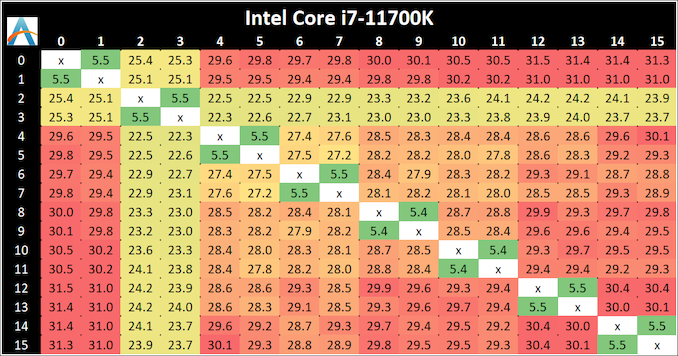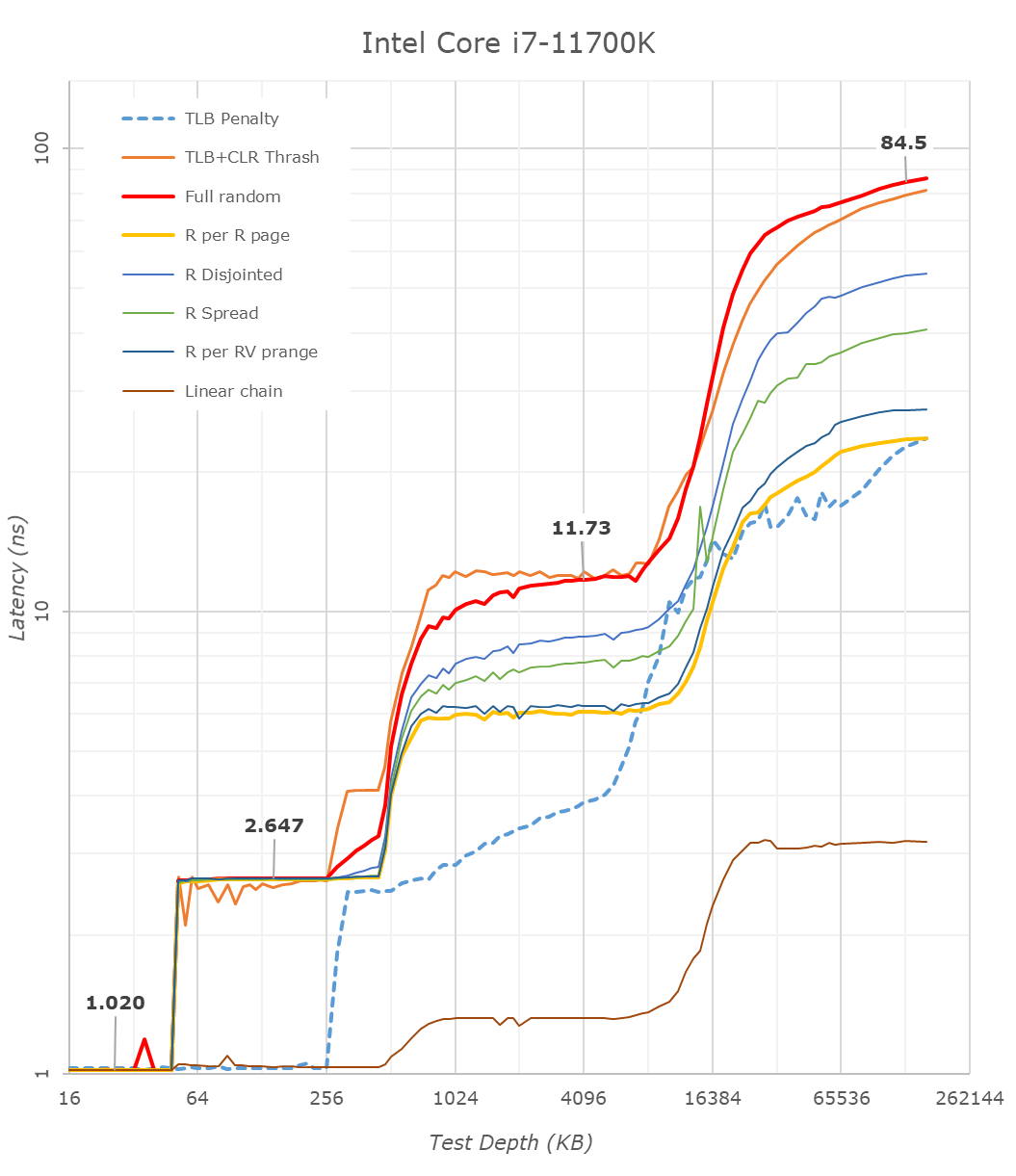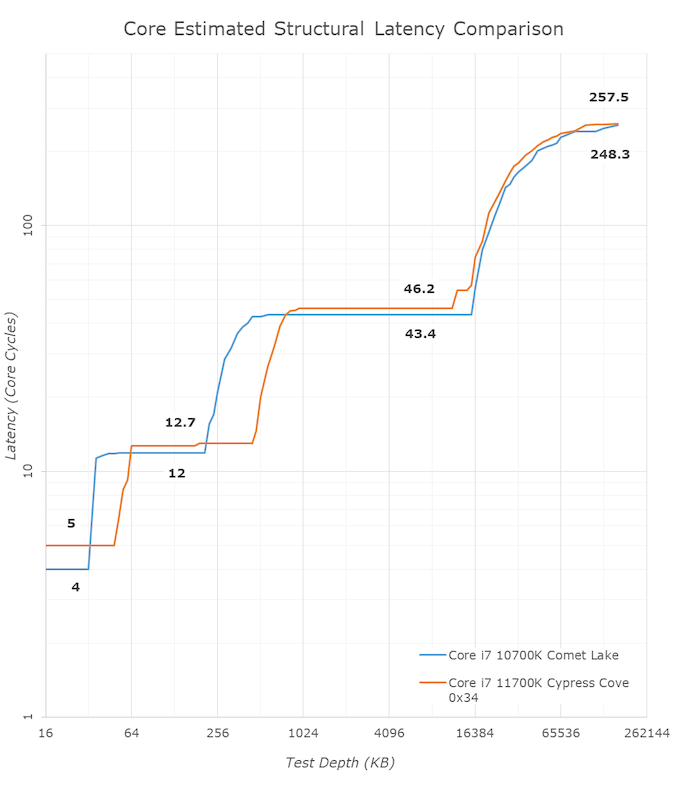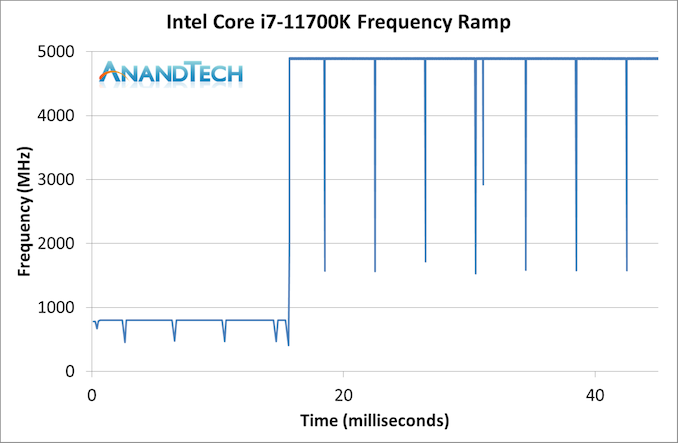Intel Core i7-11700K Review: Blasting Off with Rocket Lake
by Dr. Ian Cutress on March 5, 2021 4:30 PM EST- Posted in
- CPUs
- Intel
- 14nm
- Xe-LP
- Rocket Lake
- Cypress Cove
- i7-11700K
CPU Tests: Microbenchmarks
Core-to-Core Latency
As the core count of modern CPUs is growing, we are reaching a time when the time to access each core from a different core is no longer a constant. Even before the advent of heterogeneous SoC designs, processors built on large rings or meshes can have different latencies to access the nearest core compared to the furthest core. This rings true especially in multi-socket server environments.
But modern CPUs, even desktop and consumer CPUs, can have variable access latency to get to another core. For example, in the first generation Threadripper CPUs, we had four chips on the package, each with 8 threads, and each with a different core-to-core latency depending on if it was on-die or off-die. This gets more complex with products like Lakefield, which has two different communication buses depending on which core is talking to which.
If you are a regular reader of AnandTech’s CPU reviews, you will recognize our Core-to-Core latency test. It’s a great way to show exactly how groups of cores are laid out on the silicon. This is a custom in-house test built by Andrei, and we know there are competing tests out there, but we feel ours is the most accurate to how quick an access between two cores can happen.
The core-to-core numbers are interesting, being worse (higher) than the previous generation across the board. Here we are seeing, mostly, 28-30 nanoseconds, compared to 18-24 nanoseconds with the 10700K. This is part of the L3 latency regression, as shown in our next tests.
One pair of threads here are very fast to access all cores, some 5 ns faster than any others, which again makes the layout more puzzling.
Update 1: With microcode 0x34, we saw no update to the core-to-core latencies.
Cache-to-DRAM Latency
This is another in-house test built by Andrei, which showcases the access latency at all the points in the cache hierarchy for a single core. We start at 2 KiB, and probe the latency all the way through to 256 MB, which for most CPUs sits inside the DRAM (before you start saying 64-core TR has 256 MB of L3, it’s only 16 MB per core, so at 20 MB you are in DRAM).
Part of this test helps us understand the range of latencies for accessing a given level of cache, but also the transition between the cache levels gives insight into how different parts of the cache microarchitecture work, such as TLBs. As CPU microarchitects look at interesting and novel ways to design caches upon caches inside caches, this basic test proves to be very valuable.
Looking at the rough graph of the 11700K and the general boundaries of the cache hierarchies, we again see the changes of the microarchitecture that had first debuted in Intel’s Sunny Cove cores, such as the move from an L1D cache from 32KB to 48KB, as well as the doubling of the L2 cache from 256KB to 512KB.
The L3 cache on these parts look to be unchanged from a capacity perspective, featuring the same 16MB which is shared amongst the 8 cores of the chip.
On the DRAM side of things, we’re not seeing much change, albeit there is a small 2.1ns generational regression at the full random 128MB measurement point. We’re using identical RAM sticks at the same timings between the measurements here.
It’s to be noted that these slight regressions are also found across the cache hierarchies, with the new CPU, although it’s clocked slightly higher here, shows worse absolute latency than its predecessor, it’s also to be noted that AMD’s newest Zen3 based designs showcase also lower latency across the board.
With the new graph of the Core i7-11700K with microcode 0x34, the same cache structures are observed, however we are seeing better performance with L3.
The L1 cache structure is the same, and the L2 is of a similar latency. In our previous test, the L3 latency was 50.9 cycles, but with the new microcode is now at 45.1 cycles, and is now more in line with the L3 cache on Comet Lake.
Out at DRAM, our 128 MB point reduced from 82.4 nanoseconds to 72.8 nanoseconds, which is a 12% reduction, but not the +40% reduction that other media outlets are reporting as we feel our tools are more accurate. Similarly, for DRAM bandwidth, we are seeing a +12% memory bandwidth increase between 0x2C and 0x34, not the +50% bandwidth others are claiming. (BIOS 0x1B however, was significantly lower than this, resulting in a +50% bandwidth increase from 0x1B to 0x34.)
In the previous edition of our article, we questioned the previous L3 cycle being a larger than estimated regression. With the updated microcode, the smaller difference is still a regression, but more in line with our expectations. We are waiting to hear back from Intel what differences in the microcode encouraged this change.
Frequency Ramping
Both AMD and Intel over the past few years have introduced features to their processors that speed up the time from when a CPU moves from idle into a high powered state. The effect of this means that users can get peak performance quicker, but the biggest knock-on effect for this is with battery life in mobile devices, especially if a system can turbo up quick and turbo down quick, ensuring that it stays in the lowest and most efficient power state for as long as possible.
Intel’s technology is called SpeedShift, although SpeedShift was not enabled until Skylake.
One of the issues though with this technology is that sometimes the adjustments in frequency can be so fast, software cannot detect them. If the frequency is changing on the order of microseconds, but your software is only probing frequency in milliseconds (or seconds), then quick changes will be missed. Not only that, as an observer probing the frequency, you could be affecting the actual turbo performance. When the CPU is changing frequency, it essentially has to pause all compute while it aligns the frequency rate of the whole core.
We wrote an extensive review analysis piece on this, called ‘Reaching for Turbo: Aligning Perception with AMD’s Frequency Metrics’, due to an issue where users were not observing the peak turbo speeds for AMD’s processors.
We got around the issue by making the frequency probing the workload causing the turbo. The software is able to detect frequency adjustments on a microsecond scale, so we can see how well a system can get to those boost frequencies. Our Frequency Ramp tool has already been in use in a number of reviews.
Our ramp test shows a jump straight from 800 MHz up to 4900 MHz in around 17 milliseconds, or a frame at 60 Hz.














541 Comments
View All Comments
arashi - Friday, March 5, 2021 - link
He's probably just a salty competing review website owner upset that he didn't think to do this first.jonathan1683 - Friday, March 5, 2021 - link
I am an intel fanboy, but I dont agree with you at all either, intel scewed up and they have to deal with that, they wont fix anything the motherboards are made the cpus are retail and being sold. Anand did me a solid. I literally was about to pre buy all my stuff for rocket lake now I am not. If intel does pull some kind of magic they can change the reviews. No harm if something changes, but I don't think it will. I don't want AMD either so I am without a home right now also not really interested in big little cores either unless it pulls off some magic. This is also just a hardware review site not some major corporation not sure why you hold them to such a high standard.SaturnusDK - Saturday, March 6, 2021 - link
big-little cores will help improve efficiency so the mobile parts may become competitive again but for desktop parts it will almost certainly decrease performance rather than increasing it. There is literally zero chance that the scheduler will always get it right which processes are assigned to which cores, and moving processes between different core types will always incur a performance hit.Cooe - Saturday, March 6, 2021 - link
"I don't want AMD either"Uhhh... why not? Deliberately not buying the best products available on the market because of the company that made them doesn't make ANY SENSE unless the company being referred to tends to be on the wrong side of basic business ethics/morality. You are cutting off your nose to spite your face here for no other reason than some misplaced stupid fanboy loyalty... -_-
TheinsanegamerN - Monday, March 8, 2021 - link
Criticism of intel for releasing a hot dung heap isnt "AMD worshipping".Spunjji - Saturday, March 6, 2021 - link
Trying to make a moralistic critique out of your own personal objections is a desperate move.If Intel want to do pre-orders before they've even announced the product, yet they're going to release stock to a retailer, then personally I'm only too happy for one of the best CPU testing websites out there to buy one and put the screws to it.
scineram - Saturday, March 6, 2021 - link
Why didn’t they buy one then?dsplover - Friday, March 5, 2021 - link
What a waste of time.5xxx is the better Design.
3xxx series is when Intel should’ve noticed they were in trouble.
Lucky for them I don’t need the best, just the most mature hassle free CPU.
But I’m not buying anything until the server parts 480/1200 Xeons drop prices.
If AMD can deliver on the 5xxx APU before that, I’m going to jump ship.
blppt - Saturday, March 6, 2021 - link
I'm not sure anybody saw the massive single thread or core performance jump from the 3 series to the 5 series. I remember being astonished at the geekbench and CB synthetics, thinking there was something bugged somewhere.3xxx Zen was good, but 5xxx series is outstanding.
Otritus - Saturday, March 6, 2021 - link
Zen 2 was always market as a a zen++ that for some reason had a massive enough performance uplift to be comparable to a new microarchitecture. Zen 3 on the other hand was marketed as a newly designed microarchitecture with the largest ipc improvements (from AMD) since zen. AMD delivered exactly what was promised, a significantly faster and more efficient product on 7nm.The reason why you would have been astonished by the synthetics is because we haven't had a typical (15-30%) microarchitecture performance uplift since sandy bridge. Haswell was only ~11% faster than ivy bridge. The thing that we didnt see coming was zen 3 being called 5000 instead of 4000 and the price hikes.